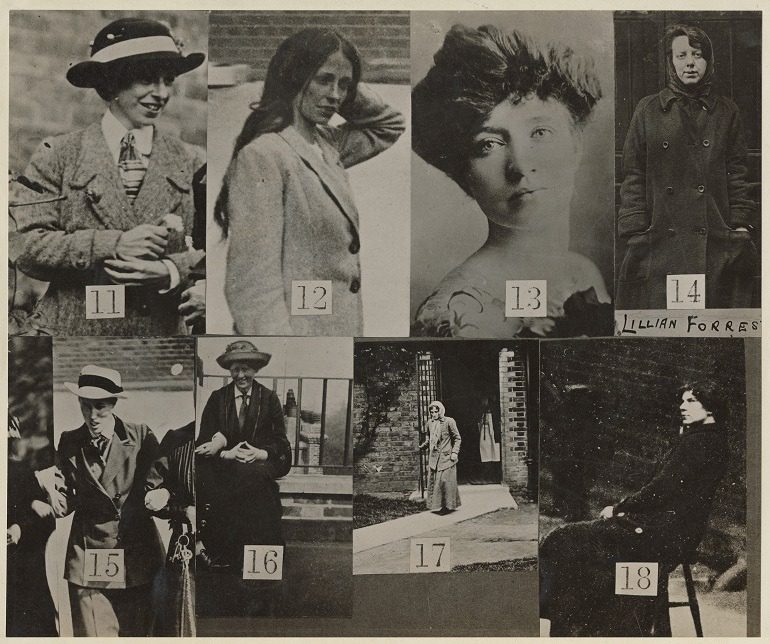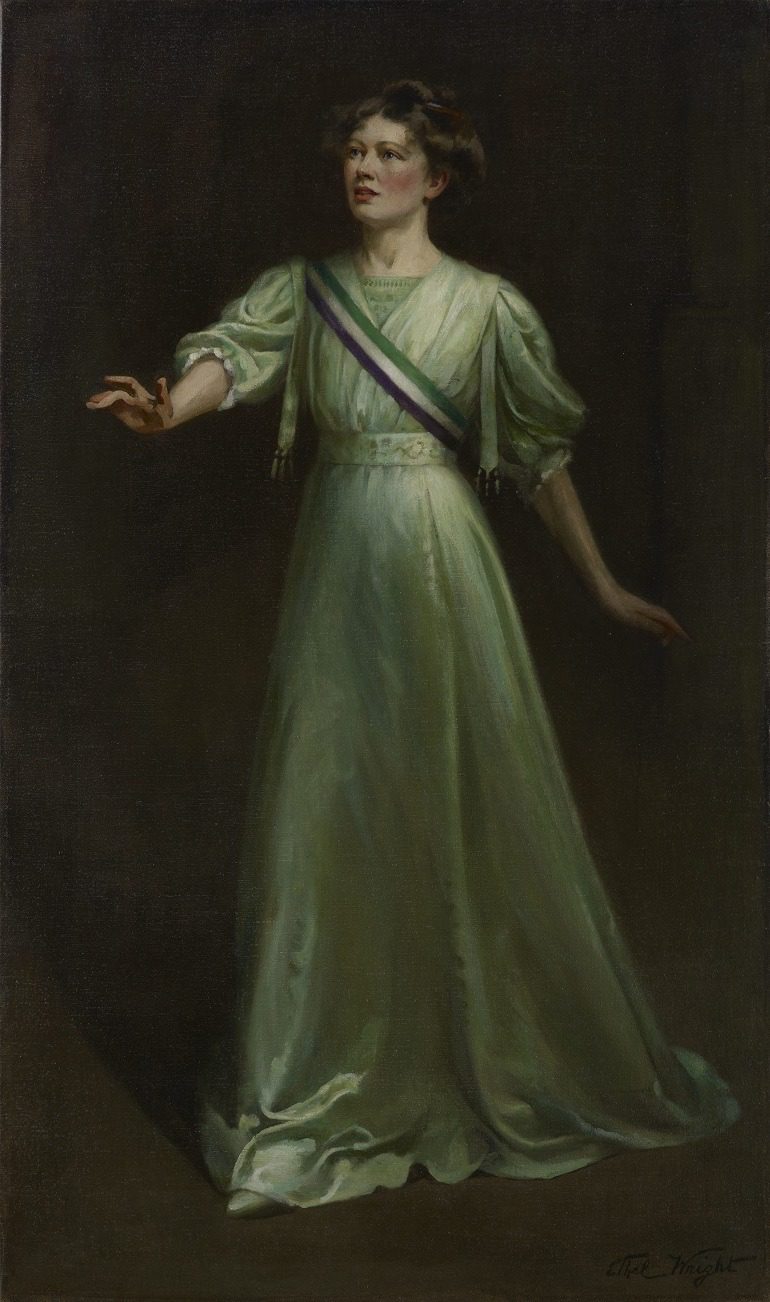ART & DESIGN
Emmeline Pankhurst’s arrest at Buckingham Palace by an unknown photographer, 21 May 1914 shows women’s for the right to vote. Image courtesy of National Portrait Gallery, London
ART REVIEW: Women’s Suffrage art exhibition at the National Portrait Gallery memorializes Women’s Right to Vote and struggles for equality.

Surveillance Photographs of Militant Suffragettes by Criminal Record Office, 1914. Image courtesy of National Portrait Gallery, London
LONDON— Women’s right to vote and the fight for equality is at the center of a newly acquired portrait of Christabel Pankhurst presently on display at the National Portrait Gallery. A leading Suffragette, Pankhurst was a women’s right activist, who risked her life to ensure that women got the right to vote. This is the first time the painting is going on display in eighty years.
Christabel Pankhurst’s portrait is part of a new exhibition at the National Portrait Gallery. Titled Suffragettes: Deeds not Words, the show includes photographs and archive material marking 100 years of women’s suffrage movement in England. The show illuminates the history of women’s suffrage and a period when key members of the Suffragettes attacked the National Portrait Gallery, destroying important paintings to draw attention to their cause. Disenchanted that their messages were not getting through, the Suffragettes, after years of peaceful demonstrations, embraced violence to get their voices heard. Their action escalated to civil disobedience and serious vandalism, including arson and bombing. This was just before the outbreak of the First World War.
Early women’s suffrage timeline in England was characterized by peaceful demonstration as Suffragettes quest for women’s right to vote, and the opportunity to influence policies that would affect their lives. However, it soon became clear that their cries were falling on deaf ears in a patriarchal society that women were subordinate to men. Despite petitions to parliament demanding women’s enfranchisement, by the first decades of the twentieth century, women continued to be denied entry into the ‘boys club’, and the ability to influence policies that directly affect their lives. Disillusioned by such powerlessness, the Suffragettes went on a rampage. The result was absolute anarchy.
Suffragettes: Deeds not Words details the activities of the Suffragettes fight for women’s right to vote. The show includes a selection of rare photographs of the Suffragettes campaigning for women’s right and equality. In this struggle for the actualization of women’s right, a number of women Suffrage leaders were put under surveillance by the Criminal Record Bureau. Those Surveillance photographs, which were issued to the National Portrait Gallery by the Criminal Record Bureau in 1914, are part of this display. Also on display are original archive documents that take viewers on a historic journey to the attack on the National Portrait Gallery and damage caused by the Suffragettes. Viewers are presented with the central character of the attacks as they explore violence to get their point across. Anne Hunt, for instance, did significant damage to the National Portrait Gallery’s painting of its founder Thomas Carlyle by Millais. The Suffragettes also damaged the Royal Academy’s portrait of Henry James by Sargent, now in the National Portrait Gallery Collection.
One of the major features of the exhibition is Christabel Pankhurst’s portrait by Ethel Wright. The portrait is stunning in the true sense of the word. The full-length portrait shows Pankhurst in a flowing green dress, exuding courage and confidence. She stands tall, bold and poised. This is evidently the portrait of a woman without fear. Captured in the most dramatic pose, and illuminated against a dark background, Pankhurst is portrayed as though she could be marching or speaking passionately on a stage. Across her chest is the sash with the distinctive and symbolic colored stripes adopted by many Suffragettes – purple for dignity, white for purity and green for hope.
The inclusion of Pankhurst’s portrait in the show brings context to the exhibition. It helps highlight the history of the subjugation of women in the early twentieth century. Pankhurst struggles as a Suffragette exemplifies the struggle of women and the effort to bring dignity to them. A trained lawyer with a first-class law degree from Manchester University, Pankhurst was unable to practise as a barrister because she was a woman. The male dominated society ensured that women were subservient and powerless. But instead of despairing, Pankhurst channeled her ability in other areas. She used her legal knowledge in speeches and pamphlets to highlight the inequality faced by women. She was an inspirational speaker and astute strategist, and symbol for the militant suffrage movement. Pankhurst was the daughter of Emmeline Pankhurst, a primary strategist in the Women’s Social and Political Union, the suffrage organisation founded to galvanise the campaign for women’s right to vote in the early twentieth century.
First displayed at the radical Women’s Exhibition staged in Kensington, London, in 1909, Pankhurst’s portrait shows the dexterity of Ethel Wright, a society painter who supported the suffrage cause. In an age when women were seen as unequal to men in skill and intellect, Ethel Wright’s artistic skill was instructive. Showing off Wright’s skill, as part of the campaign for women’s suffrage, was one of the purposes of the Women’s Exhibition. Organized by the Suffragettes, the show was ingeniously promoted as a traditional village fete and a showcase of women’s skills and ability. Beyond the display of women’s skills, however, Women’s Exhibition was effectively used to raise funds for the militant group and to raise awareness of their cause. Since that first outing, Pankhurst’s portrait has only been seen at two small exhibitions in the early 1930s, organised by suffrage societies. Purchased by prominent Suffragette Una Dugdale Duval in 1909, the portrait has remained with the family until this bequest.
Suffragettes: Deeds not Words is a journey into women’s right history. The Women’s suffrage pictures document a period when women’s right activists were the subject of surveillance and arrests. It opens up the history of when women were discriminated against and subjugated. In this exhibition we see the arrest of Suffragettes, including Emmeline Pankhurst’s at Buckingham Palace. The portrait of Mary Richardson, who was notorious for attacking the ‘Rokeby Venus’ by Diego Velasquez at the National Gallery show the extent women went through to be recognized in a male dominated society. Even more revealing is Emily Davison’s funeral procession. She, like many other Suffragettes, laid the foundation for Women’s right today. While the struggle for Women’s right to vote has been achieved, it is clear from recent events that the fight for a just and equitable society for women continues.
ART & DESIGN | READ ALSO: Famous Portrait Photographer Hans Gedda Captures Intimate Moments and Emotions

Dame Christabel Pankhurst by Ethel Wright, exhibited 1909. Image courtesy of National Portrait Gallery, London
